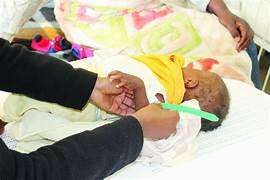Rising Stunting Rates in Lesotho: Addressing Malnutrition Through Local Initiatives
20 November 2023 by Monyane Khau

Ministry of Health Nutrition Manager, Lisemelo Seheri, says malnutrition is prevalent in both urban and rural areas. Credit: Lisemelo Seheri.
In Lesotho, an alarming 35 percent of children under the age of five suffer from stunted growth, with Mokhotlong and Botha-Bothe leading in this worrying trend.
Lisemelo Seheri, Nutrition Manager at the Ministry of Health, explains that Lesotho faces a triple burden of malnutrition, involving over-nutrition (increasing rates of overweight and obesity), under-nutrition (underweight, wasting, and stunting), and micronutrient deficiency, commonly known as “hidden hunger” due to its subtle impact, detectable only through specialised tests.
World Health Organisation (WHO) describes micronutrient as vitamins and minerals needed by the body in very small amounts.
“However, their impact on a body’s health are critical, and deficiency in any of them can cause severe and even life-threatening conditions,” highlights WHO.
Seheri says tripe burden of malnutrition in Lesotho, including micronutrient deficiency, are caused by a couple of factors.
“Key causes of malnutrition among children under five include poor feeding and care practices and the inability to access health services when needed,” Seheri told Uncensored News on 14 November 2023.
Tip of the iceberg
Children and adolescents make up 38 percent of the Lesotho population, and according to the United Nations Children’s Fund (UNICEF), people living in rural areas, women, and children are disproportionately poor.
“Despite numerous child-focused poverty reduction programmes, children remain the hardest hit by poverty in Lesotho: 65 percent of all children in Lesotho are simultaneously deprived of at least three basic social services.
“Under-five mortality remains a challenge, especially for boys (102 per 1,000 live births). Common causes of death among children include prematurity, birth asphyxia, pneumonia, and malnutrition,” reads a UNICEF Country Focused Report, 2020.
The report further indicates that food insecurity, resulting from Covid-19 lockdown restrictions and extreme weather events due to climate change, had a direct impact on the nutritional well-being of children.
UNICEF says one-third of children in Lesotho are stunted, which is 92,000 children under the age of five, a number that has increased in recent years from 33 percent in 2014 to 35 percent in 2018.
Ministry of Health Nutrition Manager Lisemelo Seheri says insufficient resources such as finances and some cultural norms that deprive children of eating certain foods cause malnutrition among children below the age of five.
“Poor hygiene practices and unsafe drinking water, which may result in diarrhoea, and the inability to access health services when needed cause malnutrition in children aged below five,” Seheri said.
She adds: “Mokhotlong has the highest number of children stunted, followed by Botha-Bothe, and both have the same highest number of children with anaemia.”
Contrary to some beliefs that malnutrition is more prevalent in poverty-stricken households, Seheri says because of lack of knowledge, data shows that there are also malnourished children in urban areas.
“Even families that can afford to feed their babies, we still found cases of malnutrition but they are able to quickly address those challenges,” Seheri said.
In Ha Pataka, Botha-Bothe, lives ‘Mamatlang Khatamela, a Village Health Worker who daily interfaces with persons in her village faced with a myriad of health challenges, including malnutrition among underage children.
Khatamela says there is one particular family that has two children aged under five, who keep losing weight with every monthly visit to the clinic. These siblings were born on 12 April 2022 and 17 August 2022.
“We have a challenge of malnutrition in this village. We have two children from one family who are malnourished,” Khatamela told Uncensored News on 15 October 2023.
According to Khatamela, the eldest sibling lost weight months after birth, and village health workers in Ha Pataka encouraged the mother to feed the child well.
“She told us that she does not have food. We talked to the ministry, and a child was given a plumpy nut and food for the whole family. The child’s body weight improved a lot,” she said.
While village health workers and nurses at Ha Tsime clinic celebrated this development, the mother gave birth to a second child.
“The second child lost weight as well. We encouraged the mother to try and do farming through lentloane (climate-smart farming),” Khatamela said, adding, “She is quite slippery, sometimes she goes to her maternal parents’ house.”
She says village health workers in the area are having a hard time with her. “Both her children are losing weight.”
The malnutrition problem in children is a visible sign pointing to the broader and more severe challenge of famine that is about to happen in the country.
In November 2023, a Famine Early Warning Systems Network (FEWS Net) released a Lesotho Acute Food Insecurity Report which warns that “very poor and poor households will likely be Stressed (IPC Phase 2) through the scenario period as high food prices limit their access to their non-food needs.”
Soaring food prices
FEWS Net says following a near-average national harvest in 2023, markets are well supplied with maize meal at the start of the lean season.
“However, market prices remain higher than last year and the five-year average. The high prices are likely impacting household purchasing power.
“Staple food prices will likely remain high through the lean season as market demand increases food prices amid high transportation costs,” read the FEWS Net report.
The report further states that annual increases in staple food prices continue to impact household purchasing power and access to food.
The weak exchange rate and high international oil prices are driving higher agricultural input and transportation costs during the land preparation and planting period, highlights the report.
Another challenge that Lesotho faces is that, as stated by the report, due to the El Niño forecast, average to below-average rainfall is likely to lead to a below-average 2024 harvest of staple crops.
Khatamela proposes that families must avoid going to the shops to buy at all cost. “One does not need to go buy expensive food to feed the child well. Give the child an egg with papa, soft porridge with limited vegetable oil, not to go buy food because it is difficult for us,” Khatamela said.
Interventions

‘Mamatlang Khatamela is a Village Health Worker at Ha Pataka in Botha-Bothe district. Credit: Monyane Khau.
While Khatamela admits that the prices of food are high in Lesotho, she says families must engage in local projects like climate-smart farming and rearing free-range chickens to address food insecurities within individual families.
“Feeding a child is not that difficult because I think if a child is fed papa and soup from the green vegetables, that child will not be malnourished.”
UNICEF says in 2020, Covid-19 exacerbated serious food insecurity in Lesotho, and the number of persons projected to be food insecure jumped from 380,000 to 582,000, or almost a quarter of the entire population.
In its efforts to help Lesotho in its fight against food insecurity, UNICEF says “3,030 children under five years received treatment for malnutrition.”
Seheri says interventions like educating and counselling nursing mothers at health facilities and community levels about the importance of nutritious feeding should be intensified.
“Breastfeeding is over-emphasised in health education sessions provided to pregnant women. For breastfeeding, it is recommended that mothers should initiate breastfeeding within the first hour of life, exclusively breastfeed for six months, and continue until the child is two years or beyond.
“Age-appropriate complementary feeding and proper hygiene are key when introducing solids and other fluids other than breastmilk. Micronutrient supplementation for pregnant, breastfeeding, and children below five years are important,” Seheri said.
She says children are assessed monthly to determine their growth, and in a situation where a child’s growth alters, the family is provided with support.
On an inclusive food insecurity, one that affects children and adults alike, FEWS Net says planting vegetables will help families temporarily stay afloat. “Despite the anticipation of even higher food prices, vegetable production and the good winter wheat harvest are expected to support household access to food and income in December and January.”
Another intervention is the government’s plans to distribute maize and beans to 120 vulnerable households in each of the 80 constituencies. This means a total of 9,600 households will benefit from this distribution.
“In October, the distribution of maize and beans purchased from farmers by the government has yet to start as milling is still ongoing. The government is working with the World Food Program (WFP) to assist in the milling, fortifying, and packaging of cereals. The government plans to distribute maize and beans across 80 constituencies, with 120 vulnerable households targeted in each constituency,” reads a report by FEWS Net.
In the face of the growing challenge of malnutrition in Lesotho, it is evident that urgent action is needed. Lesotho’s commitment to the World Health Assembly’s Comprehensive Implementation Plan on maternal, infant, and young child nutrition is a crucial step forward.
Endorsed in 2012, the plan outlines six global targets aimed at reducing under-five stunting by 40 percent, anaemia in women of reproductive age by 50 percent, low birth weight by 30 percent, halt under-five overweight, increasing rates of exclusive breastfeeding as well as maintaining under-five wasting below five percent by 2025.
To effectively address these targets and improve the nutritional well-being of its population, Lesotho must now focus on implementing targeted programs, reinforcing existing policies, and fostering community-based initiatives. By working towards these goals, the nation can make significant strides in reducing malnutrition and ensuring a healthier future for its children.


